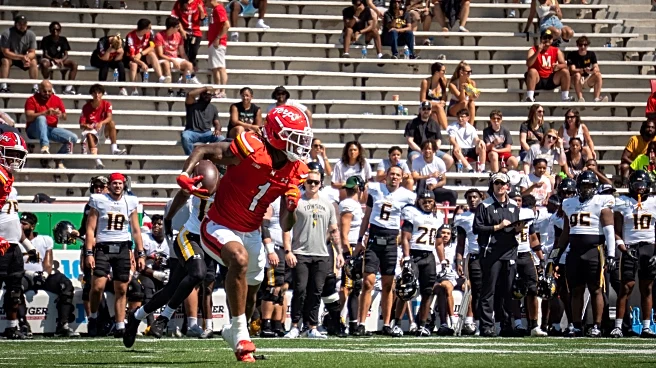Maryland coasted to victory Saturday against Towson, winning its 18th consecutive nonconference game with its largest margin of victory in over a year. The Terps were fueled by a massive early-game offensive surge — four touchdowns and two field goals from their opening six drives put the game out of reach early.
Here are three takeaways from Maryland’s final tune-up before Big Ten play.
With Washington, Maryland’s quarterback room is in good hands
Entering Saturday, it seemed unlikely that Maryland would learn much about star quarterback Malik Washington. The
freshman faced adversity against Northern Illinois the week before but recovered well to secure the game, and Towson projected to be an easier matchup.
Still, Washington put on his best display by far against Towson. He looked far more comfortable dialing up deep balls, finding Octavian Smith in stride and perfectly placing a back-shoulder bomb for Shaleak Knotts. His efficiency — Washington went 16-for-22 and hardly forced a throw all game, simply taking what the offense gave him — was an important progression to see.
Washington did throw the first interception of his career — although attributing the fault for the pick, which was scooped into the air by Nolan Ray for a Towson defensive lineman to grab, solely to the freshman is somewhat unfair. In the end, Washington has the most passing yards by a power-conference true freshman quarterback through three games since 2019. He appears to be prepared for a tougher task against Wisconsin.
Maryland was able to pull its starters midway through the third quarter, giving Terps fans their first true look at redshirt freshman quarterback Khristian Martin. Playing with the second-string offense, Martin looked like a backup option, going 5-for-7 for 15 yards, but a third-down completion showed potential.
Justyn Martin remains out with an undisclosed injury; quarterback Roman Jensen saw time after the two-minute warning.
Jalil Farooq involved early and often
Spreading the ball around remains a hallmark of Maryland’s offense, with receivers Farooq, Smith Jr., Knotts and Ryan Manning each hauling in multiple catches with the first-string offense. Farooq, though, seems to have asserted himself as the offense’s primary receiver, having caught a team-leading five passes for the second straight week.
Offensive coordinator Pep Hamilton seems to prioritize scheming Farooq into motion with the ball in his hands. Maryland’s first offensive play of the game saw Farooq motion across the line, with Washington tossing a quick sweep that went for an easy first down.
Several quick screens set the former Oklahoma speedster up similarly, with 49 of his 53 receiving yards on the day coming after the catch. Even when he didn’t end up with the ball, the threat of Farooq is something defenders are starting to notice — it was his route in the middle of the field that helped confuse Octavian Smith’s defender, allowing for a 53-yard gain that nearly finished in the end zone.
“[We’re] treating him like a Deebo Samuels type guy,” Smith said of Farooq. “Him having that body type is something I think that makes him special, able to make plays.”
Nolan Ray – and Maryland’s running game – needs a reset
Entering Saturday, the Terps’ 3.41 yards per carry ranked 105th in FBS, and their 99 rushing yards per game ranked 118th. The matchup against Towson looked to be a good opportunity to boost those numbers — its run defense is far from fierce and formidable.
A week ago, Morgan State ran through the Tigers, averaging 5.3 yards per rush on 38 carries. Even excluding Morgan State’s two longest runs of the game, Towson gave up 4.2 yards per rush to an FCS team.
On Saturday, Maryland ran the ball 42 times for 152 yards, an average of 3.6 yards per carry. While this was a small step in the right direction, plenty of concerning signs remained.
Towson regularly lined up in a 3-4 base defense, and their blockers were undersized. The Tigers didn’t have a defensive lineman weighing more than 300 pounds, and the rotating ensemble of five linemen averaged a profile of 6-foot-2 and 271 pounds.
Maryland’s offensive line had an impressive size advantage, yet they struggled to consistently create running lanes through the A- and B-gaps. Most of the Terps’ success came on outside runs and a few savvy scrambles from Washington.
Nolan Ray in particular had a concerning performance. The redshirt sophomore running back struggled to find gaps inside on the occasions they opened up – he would plunge into a two- or three-yard gain as lanes for a six- or seven-yard rush opened up alongside him. Ray finished the game averaging 2.6 yards per carry with a long of 5 yards.
Redshirt freshman back DeJuan Williams looked like the better option out of the backfield, logging 47 yards on 12 attempts. Iverson Howard also had 15 carries for 60 yards with the second-stringers. It was a sign of the times, though, that Maryland’s longest run of the day — and a tie for its season-long — was a 17-yard designed run for Washington that swung around the line entirely.

